Review - Camera Right Angle Viewfinder
Posted: 5 August 2017
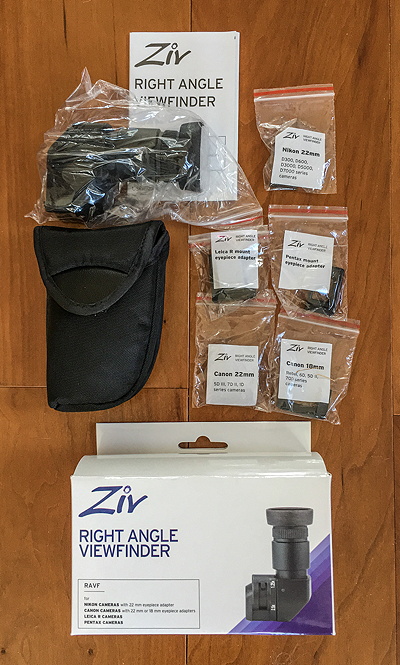
Right Angle Viewfinder
for Select Nikon, Canon, Leica, and Pentax Cameras
$60
Ziv
During my preparation for the 21 August 2017 Total Solar Eclipse I came to realize that a right angle viewfinder for my Nikon D7200 DSLR would be useful due to the Sun's position high in the sky during the Eclipse. And not only would such an accessory be useful for the Eclipse, it would be handy when doing prime focus imaging at the telescope when the object being photographed is also high in the sky. I decided to purchase the Ziv Right Angle Viewfinder for Select Nikon, Canon, Leica, and Pentax Cameras from B&H.
As seen in the photo at the right there are several items included with the purchase of the Ziv Right Angle Viewfinder: a softsided case, a small manual, and several camera adapters. The adapters provided can be used with the following cameras:
Nikon D300, D600, D3000, D5000, and D7000 series cameras
Canon 5D III, 7D II, 1D series cameras
Canon Rebel, 6D, 5D II, 70D series cameras
Leica R
Pentax
The viewfinder housing is made of plastic, but that should be OK (unless it melts during the Eclipse). The viewfinder is lightweight, which is good as it does not add much weight to the camera. Diopter can be adjusted, but the tube rotates too easily. It will likely be necessary to adjust the diopter almost everytime the viewfinder is used. Magnifications of 1.25X and 2.5X can be selected via a lever on the side. At 1.25X the exposure settings at the bottom of the D7200 DSLR viewfinder are still visible.
Attaching and removing the viewfinder is a multi-step process: slide camera eyepiece rubber cup off, slide adapter on, slide right angle viewfinder on. Reverse to remove it. With some care it is possible to keep the adapter attached to the right angle viewfinder when attaching and removing the viewfinder.
The viewfinder can be rotated 360° so that you can look through the eyepiece from any angle. The following photos show the viewfinder at three positions on my Nikon DSLR. The magnification lever on the side of the viewfinder can be seen in the top photo.
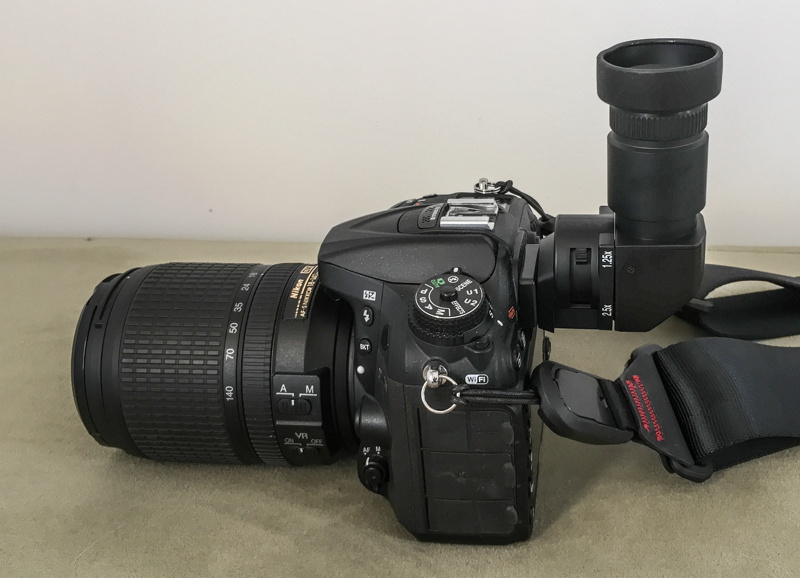
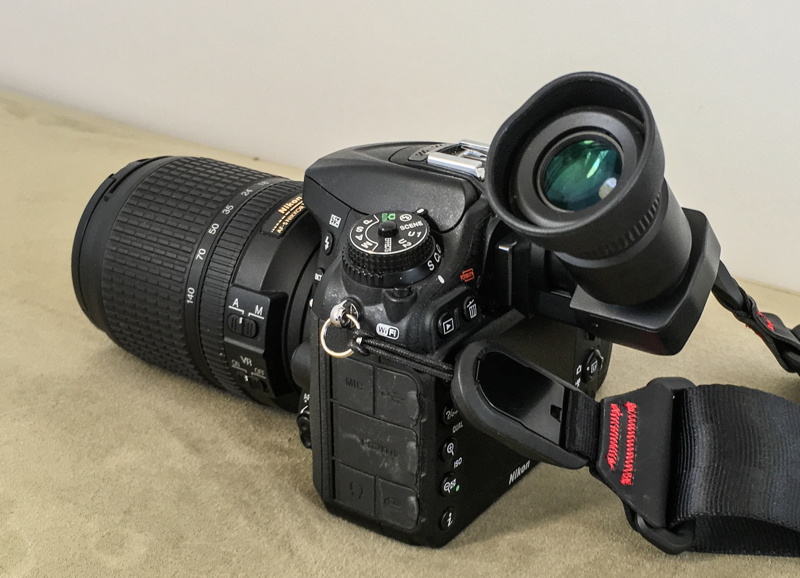
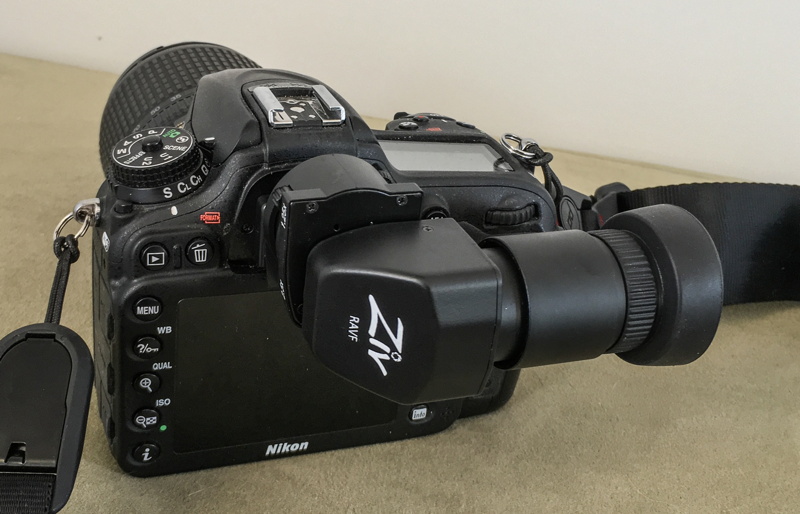
For my planned photography of the Total Solar Eclipse I will have the D7200 DSLR mounted on a sturdy tripod + an iOptron SkyTracker Pro. Due to the Sun's position high in the sky from my selected observing location, viewing normally through the DSLR would be difficult as the viewfinder and Live Screen will be facing down towards the ground. With a right angle viewfinder on the camera the problem goes away. Here is my Sun imaging setup showing the Right Angle Viewfinder on the DSLR:
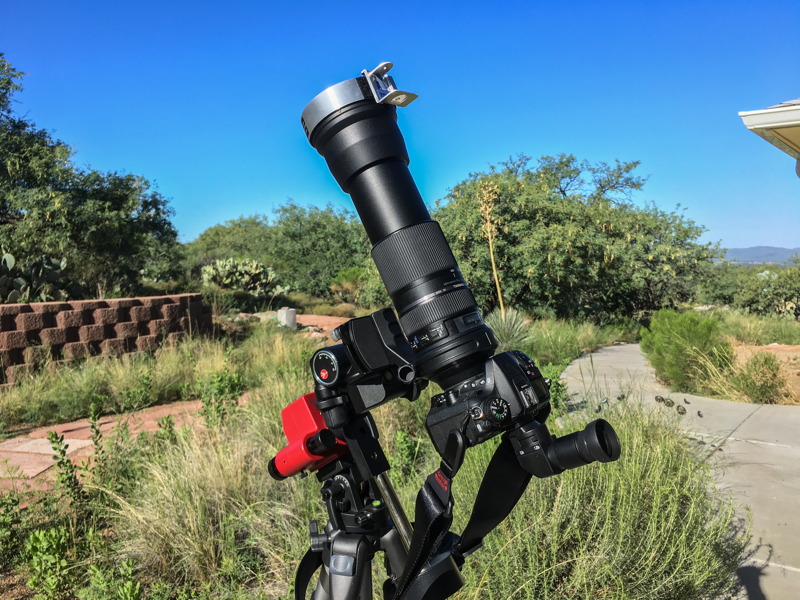
With the Right Angle Viewfinder attached I could easily check the camera field-of-view to ensure that the Sun was centered. Using a right angle finder will also allow the tripod legs to not be extended as much as I would otherwise have them for looking through the DSLR viewfinder. This will increase tripod stability. The variable magnification helped ensure a good focus on the Sun.
This is our Sun (with a small sunspot) on Saturday, 4 August 2017, taken with the above setup using the D7200 DSLR, f/6.3, 1/1000sec, ISO 400, FL 600mm:
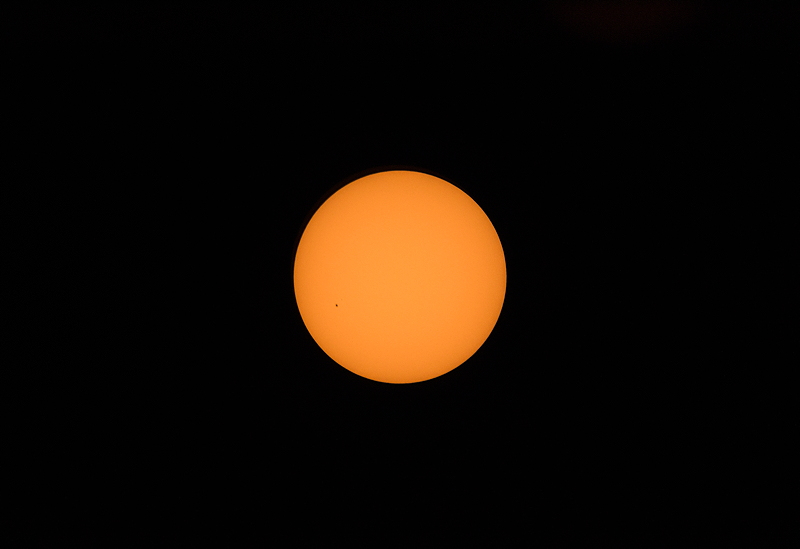
When I mount the DSLR at prime focus + visual back on the 12" LX600 telescope, objects high in the sky can be difficult to see in the camera since the viewfinder and Live Screen face down towards the ground. In the past I had to actually get down on the observatory floor to frame some objects to be photographed. When the camera is between the fork arms and close to the base, viewing through the camera's viewfinder is difficult or even impossible. Using a star diagonal on the telescope would solve the problem but using one is not always desirable or possible. With a right angle viewfinder attached to the DSLR the problem is mostly eliminated. Here is my D7200 DSLR with the Ziv Right Angle Viewfinder at prime focus of my 12" telescope.
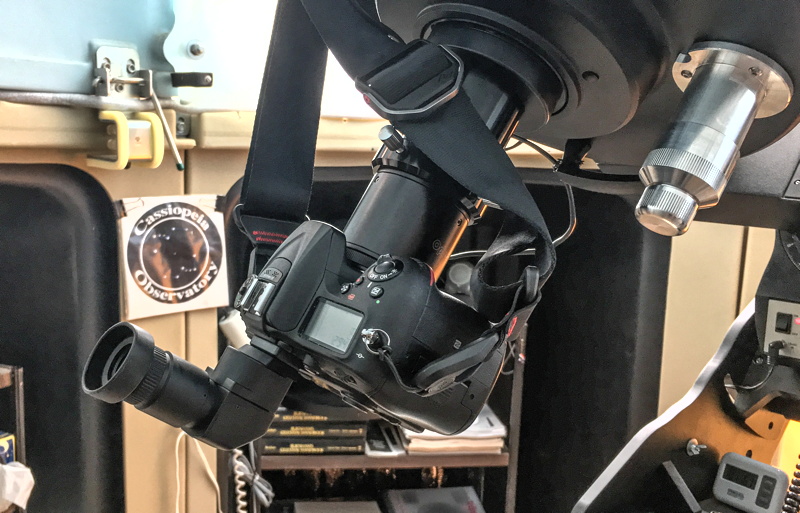
However, depending on the camera, camera adapters, telescope, and mount, there may be a clearance problem in some orientations of the telescope. With my polar mounted 12" LX600 and D7200 DSLR, the camera and/or right angle viewfinder may hit the base as the telescope approaches Declination 90°. These photos show some prime focus configurations with a Meade 2" visual back, extension, and focal reducer at or near 90° Declination:
Prime Focus [clear]
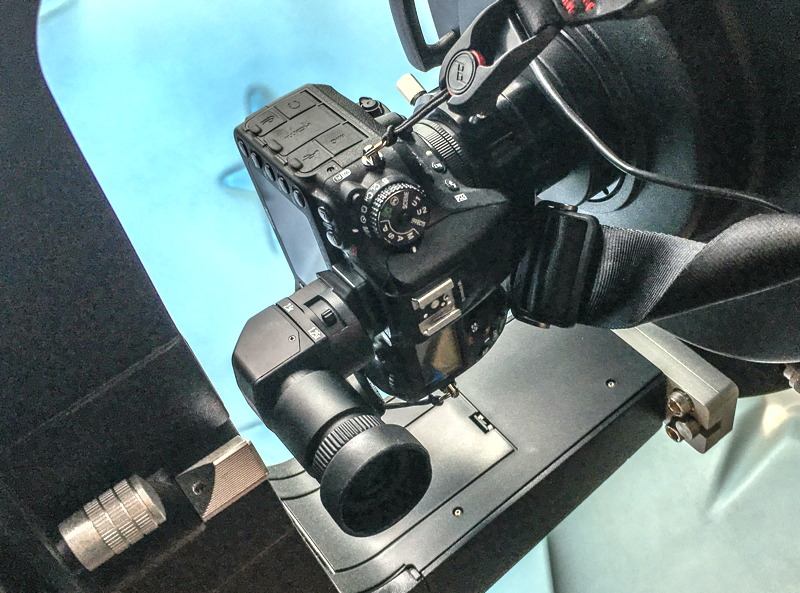
Prime Focus + Extension [bang]
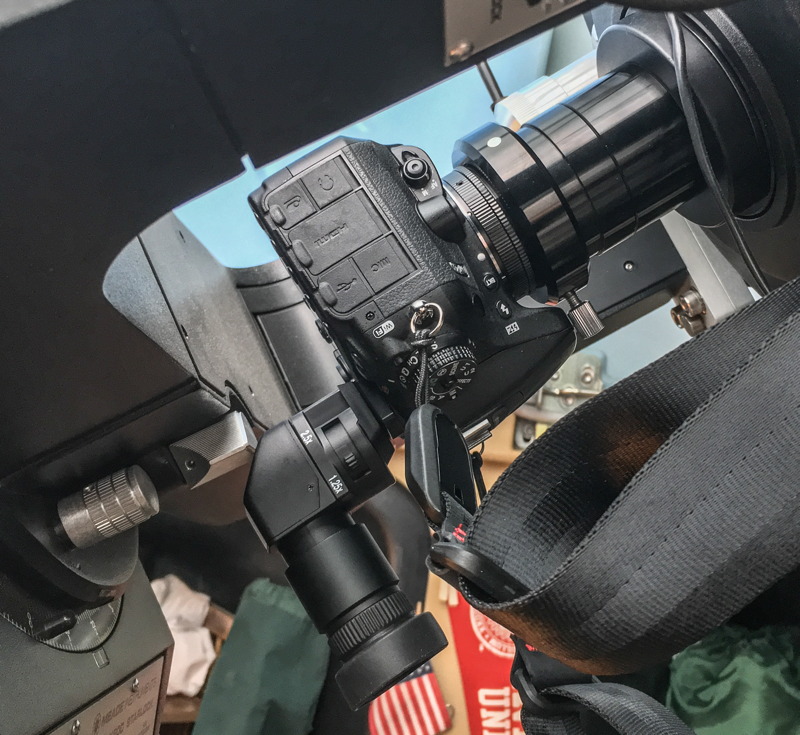
Prime Focus + Focal Reducer [bang]
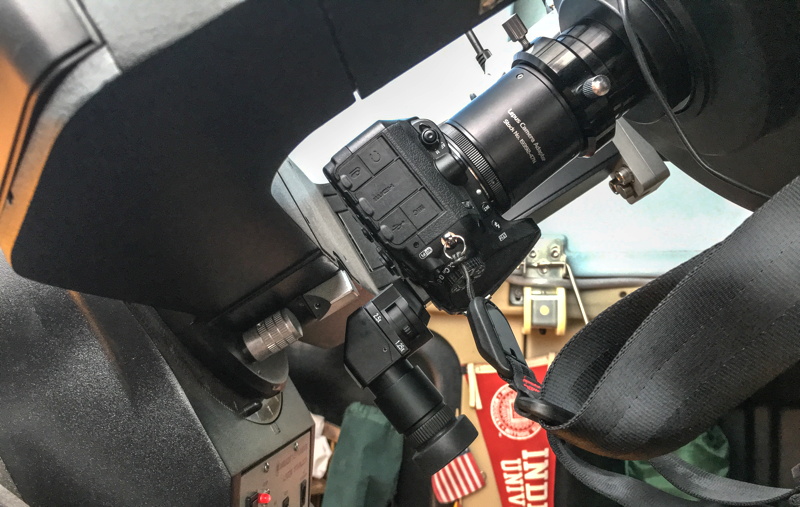
Prime Focus + Extension + Focal Reducer [BANG]
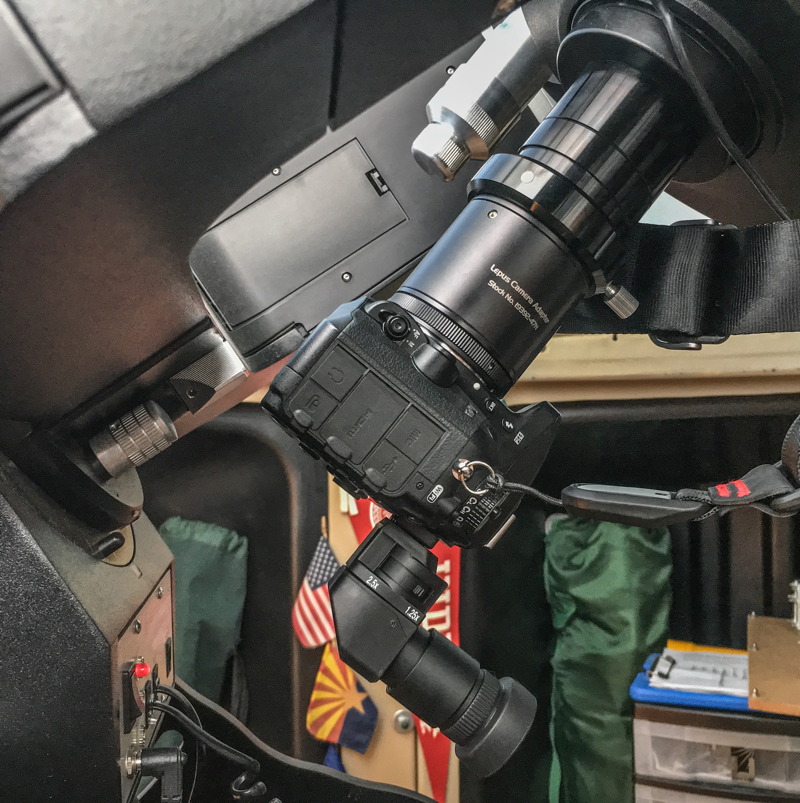
Using the Right Angle Viewfinder with the camera on the telescope was delayed for over three weeks after receiving it due to cloudy nights and thunderstorms from this Summer's Monsoon Weather Pattern. I was finally able to try out the viewfinder with the 12" telescope using a waxing gibbous Moon. I mounted the D7200 DSLR at prime focus + focal reducer (to capture the entire lunar disk). The Right Angle Viewfinder worked great with the Moon. Being able to rotate the viewfinder to a convenient position was a big plus. Using the 1.25X magnification focusing was easy. The 2.5X magnification was not as crisp as I would have liked but it was still usable. This is the Moon photo I captured with the assistance of the Right Angle Viewfinder, 1/320sec, ISO 100:
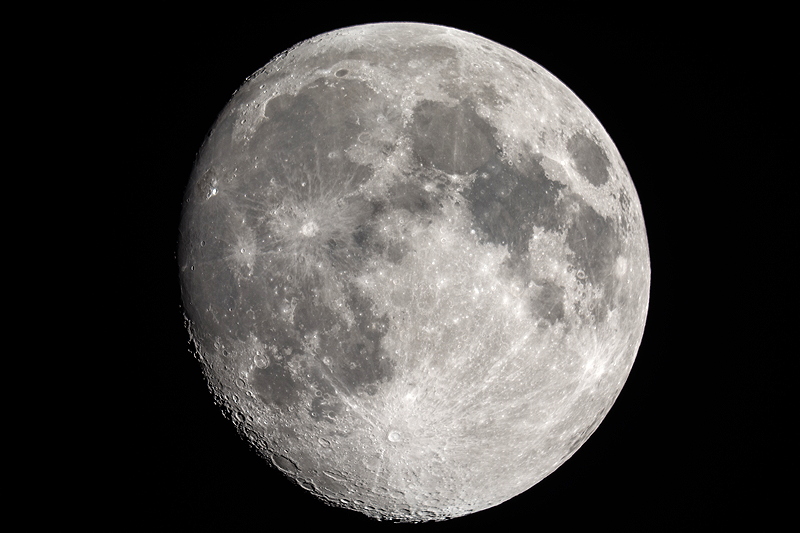
I did a focus test on the planet Saturn at prime focus + focal reducer. Both viewfinder magnifications were usable on the planet's small image.
Next, I did focus tests on the star Antares with a Bahtinov Mask. With the camera at prime focus + focal reducer the mask diffraction pattern was too small and faint to be usable with the viewfinder at either magnification. I removed the focal reducer; the mask diffraction pattern was faintly visible in the viewfinder at 2.5X and was usable. Without the mask in place, focusing on a bright star using the viewfinder was easy. However, for best focus precision, especially when using a focus mask on a dimmer star, using "Live View" on the DSLR remains the best choice whenever possible.
I then did an object framing test using the globular cluster M4. The bright Moon was nearby so the view, with and without the Right Angle Viewfinder, was hampered by the bright sky. The object was faintly visible at 1.25X, but was invisible with 2.5X magnification. I removed the Right Angle Viewfinder; the view of M4 in the normal DSLR viewfinder was similar to the 1.25X magnification view with the Right Angle Viewfinder.
I will be doing more astrophotography with the assistance of the Right Angle Viewfinder. I will report on those on future Cassiopeia Observatory reports.
Summary
The Ziv Right Angle Viewfinder is a well made add-on for your camera. It would be nice if the diopter adjustment had more friction, but that doesn't detract significantly from using it. Using a right angle viewfinder on your camera is really handy when imaging an object high in the sky. When imaging through a telescope a rotatable right angle viewfinder brings the target object to your eye at a convenient position. For the price, Ziv Right Angle Viewfinder is a useful astrophotography accessory.
Comments are welcome using Email. If you are on Twitter you can use the button below to tweet this review to your followers. Thanks.
Cassiopeia Observatory Home Page
Copyright ©2017 Michael L. Weasner / mweasner@me.com
URL = http://www.weasner.com/co/Reviews/2017/Ziv_Right_Angle_Viewfinder/index.html
